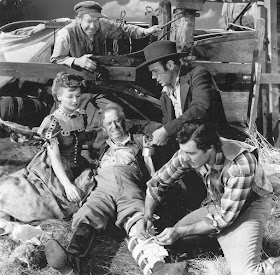“In the days before the railroad, it was the ox train that moved our mighty empire to the fabled gold coast,” reads the title credits of the 1942 western movie The Omaha Trail. “Some men saw in the new era of the railroad the end of their own ox train regime. They fought a stubborn, bloody battle of resistance. This is a story of those times, of those trains, of those men.” Yes, indeed. Our starting point in this cinematic journey is Habersford, Missouri—where “Pipestone” Ross (Dean Jagger) operates a successful ox train bidness, assisted by his partner Ben Santley (Howard Da Silva). Ben’s sister Julie (Pamela Blake) is Ross’ fiancée, his proposal sealed by a diamond engagement ring with more karats than Bugs Bunny.
So why has Ross demonstrated such agreeability—particularly when
his ox team business would be jeopardized by competition from the
railroad? Hard as it is to believe, “Pipestone”
is all for progress and is convinced that there’s plenty of room for both the
ox train and the choo-choo train. Okay,
I’m just jinkin’ ya—Ross is most displeased with this turn of events, and
informs Ben that they will accompany Pat and Vane to Omaha while scheming for a
way to (bad pun ahead) derail Vane’s burgeoning venture.
To be honest—I’m never entirely comfortable tackling an
M-G-M programmer because the gloss of that studio always makes their B-pictures
look like A-minus pictures. As such,
that’s what The Omaha Trail has
going for it; sure, it’s a routine shoot-‘em-up with Indians on the warpath and
the like, but it has one hell of an impressive cast—who nevertheless treat the humdrum
material as if it were Stagecoach
(1939).
Future Academy Award-winner Dean Jagger is in fine fettle as
the iniquitous Ross, who shows his cowardly colors at the end during the
eventual showdown with Craig’s Candel.
Personally, I thought Da Silva ran circles around him in the thespic
department; his villainy isn’t in black-and-white and despite recognizing the
threat that is Vane’s locomotive to his future business model, he’s squeamish
at the thought of people being killed (chiefly his sister, who’s accompanying
Ross to Omaha) in the process. Pamela
Blake, whom we last visited in Kid
Dynamite (1943), makes for a most beguiling ingénue (I enjoy watching
her in serials like The Mysterious Mr. M
[1946] and Ghost of Zorro
[1949]). It’s just a shame that her
marriage choices are between the oleaginous Jagger and the cardboard Craig.
Yeah, I said it. I’m
not a fan of James Craig’s…and to be even more brutal, I’m perplexed as to how
he ever had a movie career in the first place.
Most of his gigs at M-G-M in the 1940s were obtained due to his
resemblance to studio “King” Clark Gable, who was “doing his bit” in the U.S. Army
Air Force. This is not to say the actor
stunk up every movie he appeared in;
he’s surprisingly first-rate in The
Devil and Daniel Webster (1941),
mildly tol’able in Our
Vines Have Tender Grapes (1945) …oh, yeah—he’s also in While the City Sleeps (1956)—though I obviously adore watching that movie for
other reasons (Howard Duff, Ida Lupino, Vincent Price, George Sanders, etc.,
etc., etc.). When Clark was demobbed, Craig
went back to B-picture city and later did quite a bit of TV before calling it a
wrap, eventually become successful in real estate.
Chill Wills and Donald Meek provide Omaha Trail with the comic relief; the future voice of Francis, the
Talking Mule sings an infectious little ditty entitled ‘Taters and Corn (that’s later reprised by Craig’s character on a
pump organ, accompanied by the cast) while Meek effectively plays against type
as a cantankerous Scottish engineer in the employ of Ellis’ Vane. Harry Morgan (still being billed as Henry) also
channels his inner goon as Nat, a stooge who works for Ross (and who carelessly
causes an incident that brings down the wrath of a Sioux tribe the party meets
on the trail). Iron Eyes Cody and his
brother J.W. are the two Native Americans befriended by Candel (before Nat goes
on to demonstrate why we can’t have nice things), and there are bits from familiar
Western vets like Bud Geary and Ethan Laidlaw.
The Omaha Trail was
directed by actor-songwriter Edward Buzzell—who’s a bit out of his wheelhouse
with this Western (the only other oater I could find on his resume was 1940’s Go West…and that Marx Brothers romp is
stretching the definition of “Western” a bit); he’s better known for M-G-M
musicals like Best Foot Forward (1943)
and Neptune’s Daughter (1949). I was more intrigued by the producer credit;
I know Jack Chertok mostly for his small screen contributions like The
Lone Ranger, Private Secretary, and My
Favorite Martian. Short and
sweet (it’s over and done with at 61 minutes), try and catch it the next time
it airs on The Greatest Cable Channel Known to Mankind™ (it’s not on DVD).







No comments:
Post a Comment